Fostering international dialogue, exchange and collaboration
PICA’s three-year partnership with the Australia Council for the Arts brought together artists from across Australia, South Asia and Southeast Asia for the Interdisciplinary Lab from 2021 to 2023. This series of facilitated discussions, practice sharing and workshops aimed to build relationships and foster dialogue and exchange.
Facilitated by Australian artists Joel Bray Naarm (Melbourne)-based choreographer and proud Wiradjuri man, and Eugenia Lim, an Australian artist of Chinese-Singaporean descent, the program invited participants to reflect upon the nature of interdisciplinary and intercultural practice.
The Interdisciplinary Lab was initially produced by Naomi Velaphi.
Interdisciplinary Lab Artists
Eight artists were selected from the region across a mix of disciplines, heritage and lived experience. These include:
- Ade Suharto, a choreographer and performer based in Canberra/Ngambri/Ngunnawal
- Daley Rangi, a Te Atiawa Māori antidisciplinary artist based on Warrang/Sydney.
- Emma McManus, a theatre-maker and interdisciplinary artist living and working on Wurundjeri Land
- Ferial Afiff, a multidisciplinary artist living in Bandung, Indonesia
- Natasha Tontey, an artist and graphic designer based in Yogyakart, Indonesia
- Ranjana Dave, an independent artist and writer based in New Delhi
- Sheelasha Rajbhandari, a visual artist and cultural organizer based in Kathmandu
- Tiyan Baker, a Bidayǔh-Anglo video and installation artist based in Newcastle/Muloobinba
Program Background
PICA’s location in the region and proximity to South and Southeast Asia serves as an important entry point for intercultural artistic practice to be housed and cultivated. The group of artists represents eclectic approaches to artistic practice, intergenerational learning and non-western diasporic connections which encourage experimentation and exploration to thrive and be shared with PICA audiences. With rich explorations of contemporary and interdisciplinary artform practice, this program fostered meaningful dialogue and skills development and collaboration with a focus on exchange between artists living and working across Australian and South/Southeast Asian regions.
In 2021, the group participated in three phases of engagement under the banners of Encounter, Practice and Play. Each gathering provided a chance for conversations and networks to grow despite the challenges of COVID-19, and seed new ideas and possibilities for artmaking in the future. After laying the groundwork of connection and familiarity, the artists reconnected online for further dialogue and creative development throughout 2022. The labs have been an invitation to find innovative ways of fostering togetherness and embodied practice, despite limitations around travel and physical gatherings.
The key themes generated from the discussions focus on alternative methodologies and ways of thinking, expanding from the artists’ lived experiences. Engaging methods of ritual, performance, dialogue and text, the artists resist and reframe the institutional structures they encounter, to collectively ask questions such as: What is the weight of resistance? How do we create alternative realities? What do we leave behind? How is care instrumentalised by the state? What does it take to keep care radical?
“A slow burn and ripe with possibility. A wonderful and diverse group of artists. It’s been a pleasure to connect with artists across the region (across ‘Australia’ and in S/SE Asia), to feel part of a web of practice and community that extends and expands my own worldview.” — Interdisciplinary Lab artist
Biographies
Ferial Afiff
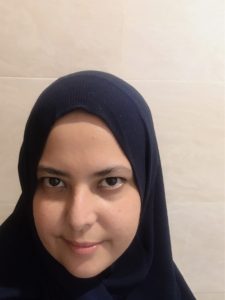
Ferial Afiff (Bandung, Indonesia) is a flexible artist who has curiosity about everything. Her hobby is participating in many different subjects/skills/backgrounds. Affif is involved with two collectives, Lifepatch (Yogyakarta, 2012–now), RUcollective (Bandung, 2020–now), and one community-hub, Gelanggang Olah Rasa/GOR (Bandung, 2021––now). In 2022, her durational performance was presented in Partisan, a solo exhibition by Otty Widasari in National Gallery, Jakarta. She recently participated in a project with LabPangan (Bandung) about food forests, discussing social disparities and revitalising old recipes. Alongside friends, she is curating Expedition Camp 2 in Tangerang – a biennial event of performance art practices across Asia. Since 2021, Ferial has been involved in historical research on Hidden Connections with Doni Ahmad under Van Abbemuseum, Eindhoven.
Tiyan Baker

Tiyan Baker is a Bidayǔh-Anglo artist who works with video, installation and photography. Her practice draws on historical research, language reclamation, digital processes and material play to explore Bidayǔh histories and subjectivities. By piecing together language, landscape and story, her practice celebrates Indigenous knowledge and explores their radical potential to upend Western ideologies. She was born and raised on the Larrakia lands known as Darwin and currently lives and works on the Awabakal and Worimi lands known as Newcastle, Australia.
Joel Bray
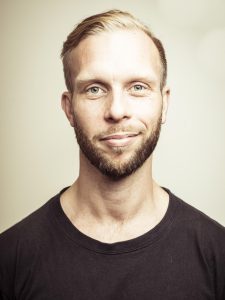
Joel Bray is a proud Wiradjuri performance-maker based in Naarm (Melbourne). As a dancer, he has performed with European companies and choreographers and with CHUNKY MOVE. Bray’s intimate dance-theatre encounters in unorthodox spaces spring from his Wiradjuri heritage, and use humour to engage audiences in rituals about sex, history, trauma and healing.
His works – Biladurang, Dharawungara, Daddy, Considerable Sexual License and I Liked It, BUT – have toured to the Brisbane, Sydney, Darwin, Midsumma, Auckland, LiveWorks and Dance Massive Festivals and Arts Centre Melbourne. Bray was the 2019 National Library of Australia Creative Arts Fellow, a 2020 New Breed choreographer with Sydney Dance Company and Chunky Move’s 2021-22 Choreographer-in-Residence. His first work for screen, Giraru galing Ganhagirri, was commissioned by Hetti Perkins for the 4th National Indigenous Art Triennial.
Ranjana Dave
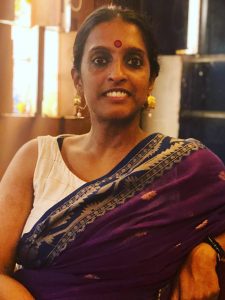
Ranjana Dave (New Delhi, India) is an independent artist and writer. Her practice, emerging from her movement training, research and writing, unfolds at the intersection of text and movement. Recent work includes co-editing Last(ing), Indent’s 2022 edition, teaching performance and critical writing courses through Ashoka University, and editing Improvised Futures: Encountering the Body in Performance (an award-winning volume, India since the 90s series, Tulika Books and West Heavens, 2021) and Age Sex Location (asl, devised performance, 2020). Previously, she was Programs Director at Bikaner House, an arts space administered by the Government of Rajasthan, and at Gati Dance Forum, an independent arts organisation in New Delhi. From 2011–2016, she was the co-founder and artistic director of Dance Dialogues, a Mumbai-based initiative that connected the local dance community to provocative and diverse ideas, individuals and institutions. Dave won the Art Writers’ Award 2022, awarded by Pro Helvetia New Delhi and Take on Art Magazine, and is beginning a new project that considers the relationship between the dancing body and performance texts, speculating what it might mean to ‘translate’ as a form of radical political practice. Through/ alongside her creative process, she also collaborates with PICA Interdisciplinary Lab artist Ade Suharto, investigating what it might mean to build a long-term, sustainable collaborative practice.
Eugenia Lim
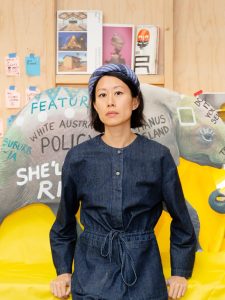
Eugenia Lim (Naarm/ Melbourne) is an Australian artist of Chinese-Singaporean descent who works across body, lens, social and spatial practice to explore how migration and capital cut, divide and bond our interdependent world. Based on the unceded lands of the Kulin Nation, Lim has shown at the Tate Modern (London), LOOP (Barcelona), Recontemporary (Turin), Kassel Dokfest (Germany), Museum of Contemporary Arts Australia (Sydney), ACCA (Melbourne), Next Wave (Melbourne), FACT (Liverpool), and EXiS (Seoul). She co-founded CHANNELS and has been an artist-in-residence with the Experimental Television Centre (New York), Bundanon Trust (NSW), 4A Beijing Studio, and Gertrude Contemporary (Melbourne). Lim is a 2022 Sidney Myer Creative Fellow and winner of Charlottenborg Spring’s 2022 Deep Forest Art Land Award.
Emma McManus
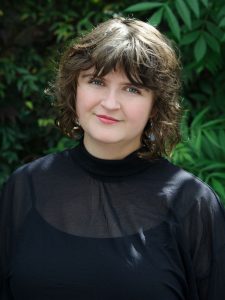
Emma McManus is an interdisciplinary artist living on Wurundjeri land. A founding member of performance collective Applespiel and Too Rude (with Maria White), she has made work for Next Wave, Sydney Festival, Performance Space, Vitalstatistix, PACT, Malthouse Theatre, Arts House, Brand X, You Are Here, Ainslie and Gorman Arts Centres and Performance Studies International (Calgary, Canada). She has interned with The Rabble, Sisters Grimm, Playwriting Australia, Karnabal – (Manila, Philippines) and Besen Family Placement at Malthouse (directing). Her new work, The Waves, is a collaboration with her physicist brother David and explores gravitational-wave science, queer theory and the biography of Virginia Woolf. She studied at the University of Wollongong, graduating with Honours (class 1) and was a peer for the Australia Council for the Arts. McManus is currently the Creative Producer of Public Programs at Next Wave. She is interested in urban ecology, plays in DIY punk bands, loves to cook a communal meal and is trying to become a better gardener.
Sheelasha Rajbhandari
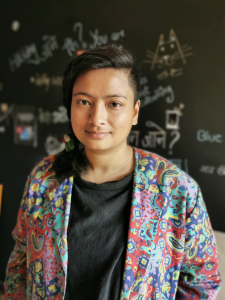
Sheelasha Rajbhandari is an artist and curator based out of Kathmandu, Nepal. Her works draw upon an embodied and speculative lineage of femininities to question the positioning of women across time, landscapes, and cosmologies. Her practice is a provocation to reflect beyond a neo-liberal conception of time in order to decent patriarchal structures that perpetuate cycles of industrial extraction and individual exhaustion. For her, art-making is about making space for collective action. This questioning feeds into her recent artistic and curatorial approach that recomposes notions of Indigeneity, gender, worth and productivity. Rajbhandari co-curated the Kathmandu Triennale 2077, Nepal Pavilion at Venice Biennale (2022), Garden of Ten Seasons’ at Savvy Contemporary, Berlin (2022) and 12 Baishakh, Bhaktapur (2015) alongside Hit Man Gurung. She is also the co-founder of ArtTree Nepal, an artist collective and Kalā Kulo, an arts initiative.
Daley Rangi

Daley Rangi is a Te Atiawa Māori antidisciplinary artist generating the unpredictable – speaking truth to power, reorienting hierarchies and investigating injustice. They have made a lot of art, not all of it good, but most of it interesting. They are neurodivergent, which appears to infiltrate their work. Speaking of, their practice has, thus far, tackled ecological sovereignty, disability ethics, ideological virality, contested histories, queer labour and the infinities of identity. For them, self-biographies are all-at-once discomforting, superfluous and crucial, in constant dialogue with colonial systems. Rangi, like their practice, is inspired by ancestry and still searching for answers. They currently reside on Gadigal country.
Ade Suharto
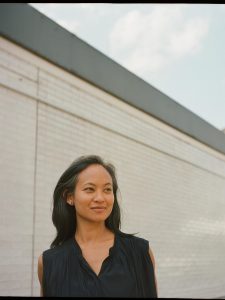
Ade Suharto is a Tarntanya (Adelaide)-born artist of Indonesian heritage. Studying aspects of the Javanese dance canon in both Indonesia and Australia frames her interest in the complexity of lineage and the sustainability of the dancing body. Suharto has presented her collaborations at Mapping Melbourne, Kings Place London, MOFO, Ubud Writers and Readers Festival, Makassar International Writers’ Festival, Adelaide Festival Centre’s OzAsia Festival, and London’s Southbank Centre. Currently, Suharto is sharing practice with Alison Currie, in sustained conversation with Padmini Chettur, and in exchange with Geraldine Balcazar and Felecia Hick on being an artist-mother and the abundance of fragmented time.
Natasha Tontey
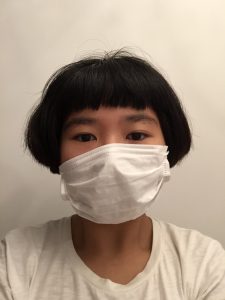
Natasha Tontey is an interdisciplinary artist based between Jakarta and Yogyakarta, Indonesia. Her artistic practice predominantly explores the fictional accounts of the history and myths surrounding ‘manufactured fear.’ In her practice, she observes any possibilities of other futures that are projected, not from the perspective of major and established institutions, but a subtle and personal struggle of the outcasted entities and beings. Her recent exhibitions include a solo exhibition at Auto Italia, London, UK (2022) and selected group shows at Singapore Biennale (2022); De Stroom Den Haag (2022); 2565, Bangkok, Thailand (2022); Protozone8 Queer Trust, Zürich, Switzerland (2022); Arko Art Council, Seoul, Korea (2022); Leeum Museum of Art, Seoul, Korea (2022); Hamburger Bahnhof, Museum für Gegenwart, Berlin (2021); transmediale, Berlin (2021); Performance Space 2021, Sydney; Other Futures, Amsterdam (2021); Singapore International Film Festival (2021); Kyoto Experiment 2021 and Asian Film Archive, Singapore (2021).
In 2020, she received the HASH Award from the ZKM, Center for Art and Media Karlsruhe and Akademie Schloss-Solitude. She is a fellow for Human Machine of the Junge Akademie at Akademie der Künste Berlin 2021–23.
Interdisciplinary Lab Supporters
Supported by Australia Council for the Arts

Image: Tiyan Baker, juruh (the thorn in durian), 2020, installation view, 2020, NSW Visual Arts Emerging Fellowship, Artspace, Sydney.



